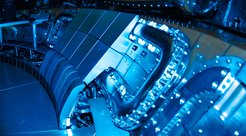IPP physicist receives Nuclear Fusion Award for work on plasma instabilities
Why can magnetic perturbations in tokamaks suppress plasma instabilities?
Physicist Dr. Wolfgang Suttrop from Max Planck Institute for Plasma Physics (IPP) has conducted groundbreaking experiments on this and has received the "Nuclear Fusion Award 2021" for it. The award is presented every year for an outstanding scientific article.
In research, the spotlight is usually on major discoveries, however, more often, it is work that confirms existing theories – or even shakes them up – that brings real progress. The latter is the case with Dr. Wolfgang Suttrop's 2018 submission to the journal "Nuclear Fusion," - the most important journal for fusion research – which has been honored as the best publication this year. The IPP physicist at the Garching site investigated the experimental conditions that can be used to suppress plasma instabilities – so-called edge-localized modes (ELMs). ELMs are one of the disturbing side effects of plasma operation. And they were first observed at IPP in 1981. As in a solar flare, intermittent bursts of hot plasma erupt regularly. "These short-lived thermal pulses stress the confining vessel wall so much that, based on current knowledge, they would make it impossible to operate ITER and subsequent fusion reactors for energy production," Dr. Suttrop explains. That's why intensive research is underway on tokamaks – including IPP’s ASDEX Upgrade – to find methods to avoid ELMs.

Researchers found an effective method in 2004 at California's DIII-D tokamak: they reported that weak magnetic perturbation fields can suppress these plasma instabilities. This was somewhat surprising. After all, fusion by magnetic confinement in tokamaks is a matter of keeping the plasma precisely in check by applying fields in an axisymmetric manner. At that time, physicists learned that slight deviations from axisymmetry can have advantages. It is true that they reduce the confinement time in previous experiments by 10 to 20 percent, but in return, they can completely eliminate ELMs, if applied correctly.
Since 2011, IPP has also been researching how to place these perturbations. At that time, Wolfgang Suttrop drove the installation of 16 perturbation coils inside the vacuum vessel of ASDEX Upgrade. They are placed only a few centimeters away from the plasma. These magnets generate a field whose strength is about one-thousandth that of regular tokamak magnets. "Experimentally, we now know very well how to use the perturbation fields," Dr. Suttrop says. "However, we still don't fully understand the physics behind it." The big question: will ELM suppression work for much larger tokamaks, i.e., ITER, DEMO and later fusion power plants? "To answer that, it is very important to work out the critical plasma properties in experiments, and if possible, to identify the physical causes," Dr. Suttrop explains. His 2018 publication, which has now won an award, starts at this point with experiments on ASDEX Upgrade. He and his team found that ELMs can be completely suppressed at all plasma rotation speeds. This is good news for ITER and DEMO.
However, the results contradict the previously prevailing hypothesis on ELM suppression. "This theory explains the influence of the perturbation field on the ELMs by the formation of small magnetic islands. However, these islands only form at certain plasma rotation velocities," Dr. Suttrop says. What he found: ELM suppression works just as well at larger rotational velocities, where no magnetic islands can be detected at all. That calls the island theory into question for now. And it explains the great attention Dr. Suttrop's paper has received. It has been cited 47 times so far in other papers. These include eleven citations by theoretical plasma physicists. They have since developed new hypotheses that integrate the experimental results from IPP.
About the 2021 Nuclear Fusion Award
"Nuclear Fusion" is the premier scientific journal on fusion. Each year, it awards the best publication that appeared three years earlier. This time gap makes it possible to measure the importance of an article also by how often it has been cited. Dr. Wolfgang Suttrop will receive the award in the second half of the year at the IAEA Fusion Energy Conference.
Publication:
